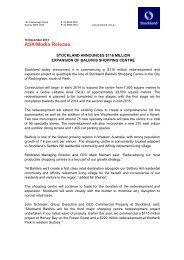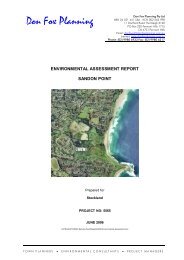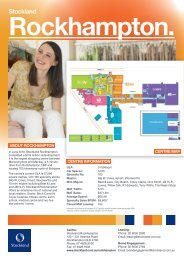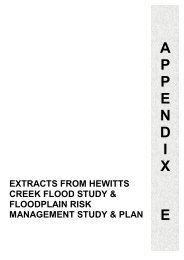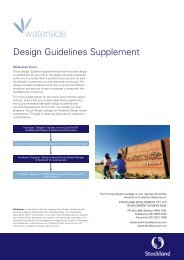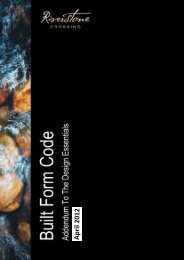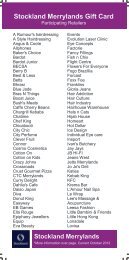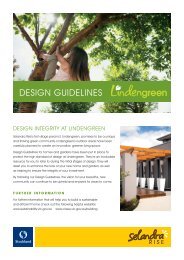CR&S Report 2009 - Stockland
CR&S Report 2009 - Stockland
CR&S Report 2009 - Stockland
Create successful ePaper yourself
Turn your PDF publications into a flip-book with our unique Google optimized e-Paper software.
ABOUT STOCKLANDWhile risks can be managed through theintroduction of policies, procedures and workpractices, we have taken the view that themost effective long-term method is throughthe creation of a risk-aware culture.Our product responsibility commitmentsare included in the following policies andprocedures:We are interested in working withorganisations that demonstrate acommitment to products responsibilityvia our Sustainable Supply Chain policy.See the ‘Engaging our suppliers’ sectionof this report (page 37).The Board Audit and Risk Committeereceives regular updates from managementand relevant external parties on the statusof risks. At the time of our equity raising inMay <strong>2009</strong> we disclosed key risks to potentialinvestors including:and UK market,issues and changes in law,For further discussion of our approachto risk management please refer to ourFinancial <strong>Report</strong> <strong>2009</strong>.The non-financial risks identified throughoutthe year are discussed in this report.GOVERNANCE AND RISKMANAGEMENTThe Board takes its governanceresponsibilities seriously and believes ithas the necessary mix of experienceand skills to oversee the high standardof corporate governance, integrity andaccountability required of a professionaland ethical organisation. For more detail,including compliance with the ASXCorporate Governance Council bestpractice recommendations, please referto our Financial <strong>Report</strong> <strong>2009</strong>.Many of our policies and charters for BoardCommittees can be found on our website.Over the past year we have reviewed andrefined our Board Committee Charters andCode of Conduct and Ethical Behaviour.As a commercial enterprise we make manybusiness decisions that entail a degreeof risk. We recognise the importance ofmanaging risk associated with our businessactivities in a manner that enables us to:cause loss,laws and regulations,Risk management is about continuouslyidentifying, evaluating, treating andmonitoring exposures.GOVERNMENT RELATIONSAs regulations have a substantial impact onour business, we proactively engage withgovernment and regulatory authorities.In July 2008 our Board implemented a zeropolitical donations policy. We do not makedonations to political parties or politiciansat any level of government. In adopting thispolicy we seek to remove any basis for doubtthat any government approvals we obtain arebased strictly and solely on the merits of ourprojects. There have been no breaches ofthis policy.We monitor legislative and regulatorychange directly through our businessesand the Corporate Affairs team, as wellas via key industry bodies. The PropertyCouncil of Australia (PCA), Green BuildingCouncil of Australia (GBCA) and ShoppingCentre Council of Australia are our primaryrepresentative bodies at both federal andstate levels. During 2008 we substantiallyincreased the frequency of our direct politicalengagement on important public policyissues.The most significant legislation affectingour business this year was the AustralianGovernment’s First Home Owners’ Boost(FHOB). The FHOB was part of the suiteof stimulatory measures introduced in late2008 to protect jobs and buttress economicactivity. The benefit to our business wassubstantial. The proportion of first homebuyers increased from 25 per cent of ourcustomer base to 65 per cent during theearly part of <strong>2009</strong>. We recognised, howeverthat this measure is best suited to distressedeconomic conditions and accordingly wesupported the tapered extension of the boostto December <strong>2009</strong>. In so doing, we alignedclosely with our industry bodies, peers andsuppliers.We made many submissions to governmentover the past year on matters such asplanning, taxation and environmentalregulation.Our regulators recognise the importantrole that our sector can play in reducingAustralia’s greenhouse gas emissionsthrough improving energy efficiencyof buildings. In addition, the FederalGovernment has continued to design anemissions trading system, referred to asthe Carbon Pollution Reduction Scheme,supported by rigorous national carbondata. As a consequence, our sectorhas encountered increasing regulatoryrequirements.Areas of strengthening regulation include:change,requirements.In general, regulation related to sustainabilityperformance has become increasinglycomplex with different layers of governmentseeking to take action. Through the PCA andGBCA we have advocated the harmonisingof reporting and regulatory requirements.Details on these regulations can be found onthe regulation page in the ‘Climate Changeand Energy’ section of this report(page 44 – 57).8<strong>Stockland</strong> Corporate Responsibility & Sustainability <strong>Report</strong> 30 June <strong>2009</strong>



